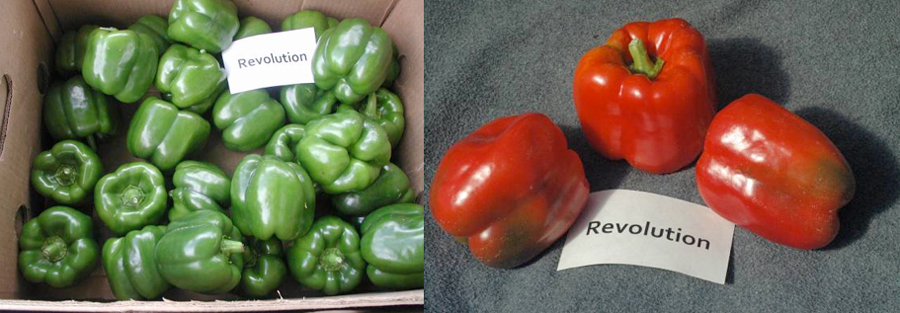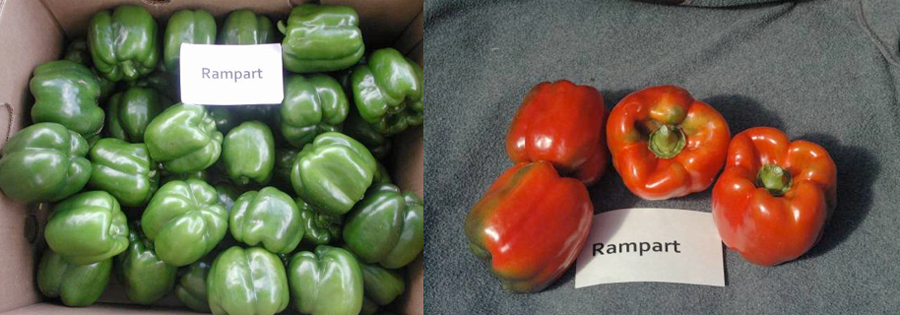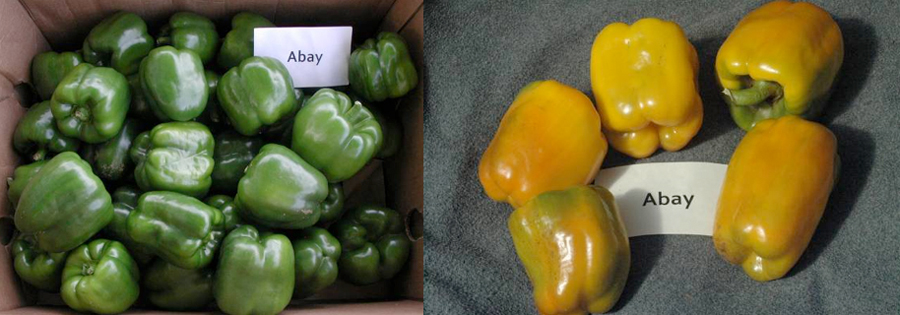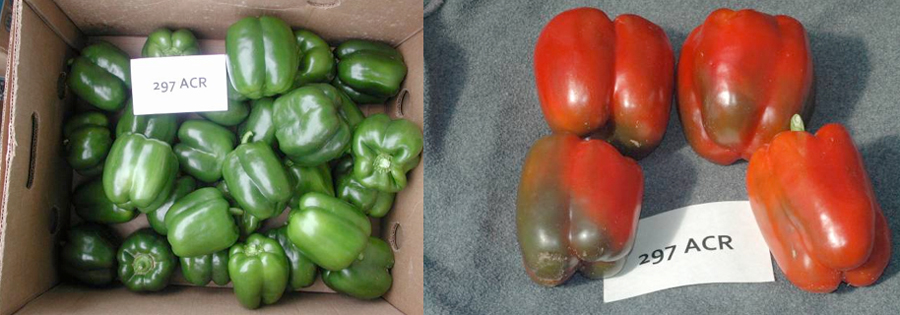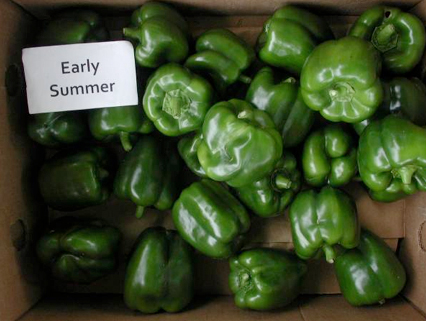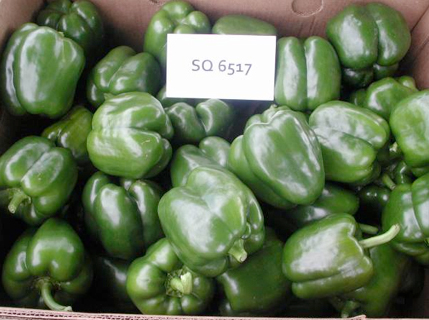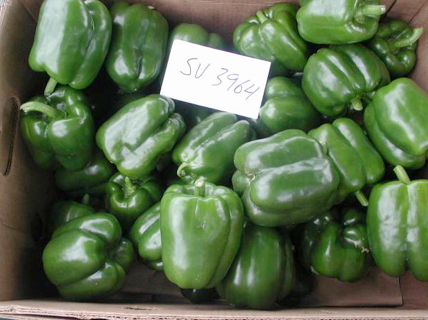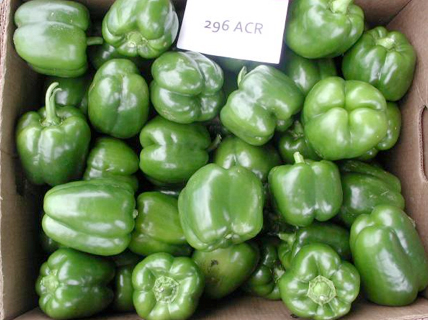Evaluation of Sweet Pepper Varieties 2013
University of Maine, Highmoor Farm, 2013
Mark Hutton, Department of Plant, Soil and Environmental Science and University of Maine Cooperative Extension
David Handley, University of Maine Cooperative Extension
Sweet peppers are an important crop for many mixed vegetable growers who sell direct to end consumers or through regional wholesale accounts in Maine. Open field production of sweet peppers in Maine is challenging due to the short and highly variable growing season. Previous sweet pepper trials in Maine from 2005-2008 identified few cultivars with commercially acceptable yields. Results from the 2013 trial appear to indicate that many of the new cultivars have much better potential for Maine.
Twenty bell pepper and three small snack size cultivars were evaluated. Plants were started in the greenhouse on April 25 and then transplanted into the field on 6/10 and 6/11. Three plots of each variety were planted in a randomized complete block design. Each plot consisted of 20 plants planted in double rows at 18 inches within row spacing. The plants were planted into black plastic covered 42-inch-wide beds spaced six feet on center. Prior to forming the beds, the field was fertilized with 10-10-10 at 500lb/acre. The plants also received 1 cup of starter solution at transplanting. Supplemental fertigation was provided on 7/19 (20 lbs N / acre), 8/6 (20 lbs N / acre), and 8/20 (5 lbs N / acre). No sprays were made to manage insect or diseases. Weeds were managed by cultivation.
| Table 1. Pepper cultivars evaluated at Highmoor Farm, Monmouth Maine, in 2013. | |
|---|---|
| Cultivar | Supplier |
| Aristotle | Seedway, Harris Seeds, Siegers Seeds, Rupps Seeds |
| Currier | Harris Seeds, |
| Islamorada | Seedway, |
| Karisma | Harris Seeds, Seedway |
| Karma | Harris Seeds |
| New Ace | Harris Seeds |
| Revolution | Harris Seeds |
| Sprinter | Harris Seeds |
| Vanguard | Seedway, Harris Seeds |
| Currier | Seedway, Harris Seeds |
| SQ 6517 | Seedway |
| Early Excursion | Siegers Seeds, Abbott and Cobb Seeds |
| Early Summer | Seedway |
| Rampart | Seedway |
| Bastille | Seedway |
| Abay | Seedway |
| FPP1814 | Seedway |
| SV 3964 | Seedway |
| 296 ACR | Siegers |
| 297 ACR | Siegers |
| 298 ACX | Siegers |
| Cupid | Johnny’s Select Seeds |
| Lunch Box | Johnny’s Select Seeds |
| Yummy Mix | Seedway |
Harvest dates in 2013 were August 7, 15, 20, 22, 27, September 4, 14, 17, 25, and October 2. The center 16 plants of each bed were harvested for data collection; the first and last pair of plants in each plot served as guard plants. Number of fruit and fruit weight were recorded for each plot. Fruit length, width, and wall thickness were determined from 10 randomly selected fruit of each variety harvested on August 15 and September 4. Plot yields were summed over all harvests prior to data analysis. There was a uniformly distributed infection of white mold (Sclerotinia sclerotiorum) across the field. The number of infected plants in each plot was counted and the percent infection for each plot was computed for each plot.
Weather summary for the 2013 growing season is presented in Table 2. Rainfall was consistent through the season with occasional periods of heavy rainfall resulting in standing water between the plant beds. The standing water and the previous sunflower crop may have contributed to the great incidence of white mold observed.
| Table 2. Monthly rainfall and average daily temperatures at Highmoor Farm, Monmouth, Maine, for the 2013 growing season. | |||||
| May | June | July | August | September | |
|---|---|---|---|---|---|
| Rainfall (in.) | 6.26 | 7.8 | 5.51 | 6.32 | 8.64 |
| Daily Average Temp (F) | 54 | 64 | 71 | 66 | 58 |
The cultivars evaluated in 2013 produced acceptable yields of marketable fruit, though Abay, Early Summer, and Sprinter were just barely acceptable. Karma, Currier, Islamorada, Karisma, and Bastille were among the better performers for marketable yield and fruit size. Six cultivars: New Ace, SQ 3517, Bastille, Islamorada, Aristotle, and Currier were reasonably early, achieving over 40% of total yield by September 1. Two cultivars, Sprinter and 296 ACR, produced less than 30% of their total yield by September 1 and may be too late for most Maine direct markets. Additionally, Sprinter had the lowest yield of the cultivars evaluated. Most of the peppers harvested in 2013 would have been graded as large (3×3 inches) in size with few extra large or jumbo fruit produced.
Three small-fruited peppers were included in this trial: Cupid, Lunch Box Mix, and Yummy Mix. Cupid is a red mini-bell pepper, while Lunch Box and Yummy are mixes of small slightly tapered red, yellow, and orange fruit. These cultivars are very productive, producing 24 to 34 fruit per plant. Harvesting these plants does require significant time and effort. These cultivars can be marketed loose by the fruit or weight or in pint or quart boxes or clam shells. A pint box holds approximately 1/2 pound of Yummy or Lunch Box; while, a quart box holds about one pound.
White mold infection ranged from below 10% infected plants (New Ace, 1.3%; Cupid, 1.3%; Lunch Box, 5.5%; Karisma, 5.6%; Revolution, 6.7%; Yummy, 7.1%) to greater than 30% (297 ACR, 35%; Rampart, 36.7%). However, there was no significant correlation between white mold infection and yield. The infection came at the end of the harvest period and thus had little impact on total yield.
| Table 3. Marketable Harvest of Bell Peppers Grown at Highmoor Farm, Monmouth Maine during the 2013 Seasonz. | ||||||||||
| Mean Values per Plot | Mean Values per 20 Fruit | |||||||||
|---|---|---|---|---|---|---|---|---|---|---|
| Cultivar | Number of Fruit | Marketable Weight (lb) | Estimated Boxes per Acre | Percent Early Harvesty | White Mold Infection % | 4 Lobe Fruit % | Weight (oz) | Length (in) | Width (in) | Wall Thickness (in) |
| Bells | ||||||||||
| Karma | 176.0 | 64.6 | 1395 | 32.4 | 10.4 | 50.8 | 5.9 | 3.89 | 2.87 | 0.26 |
| FPP1814 | 152.0 | 60.9 | 1315 | 38.0 | 23.3 | 42.1 | 6.4 | 3.47 | 2.84 | 0.29 |
| Currier | 149.7 | 58.7 | 1267 | 40.6 | 10.0 | 54.5 | 6.3 | 3.56 | 2.78 | 0.27 |
| 297 ACR | 145.3 | 57.7 | 1246 | 33.6 | 35.0 | 52.3 | 6.3 | 3.45 | 3.02 | 0.29 |
| Islamorada | 141.3 | 57.3 | 1239 | 42.5 | 11.7 | 63.4 | 6.5 | 3.48 | 2.91 | 0.26 |
| SQ 6517 | 145.0 | 54.9 | 1186 | 46.6 | 25.8 | 52.6 | 6.1 | 3.67 | 2.93 | 0.25 |
| Karisma | 130.3 | 53.0 | 1145 | 36.3 | 5.6 | 66.2 | 6.5 | 3.57 | 2.98 | 0.30 |
| Bastille | 126.3 | 52.9 | 1143 | 43.6 | 10.4 | 53.9 | 6.7 | 3.27 | 3.31 | 0.30 |
| 296 ACR | 126.7 | 52.0 | 1123 | 24.8 | 20.9 | 58.3 | 6.6 | 3.29 | 3.04 | 0.27 |
| 298 ACX | 135.7 | 51.9 | 1122 | 31.3 | 18.7 | 45.9 | 6.1 | 3.37 | 2.80 | 0.31 |
| Aristotle | 132.7 | 51.2 | 1107 | 41.6 | 10.4 | 45.3 | 6.2 | 3.38 | 2.99 | 0.27 |
| Vanguard | 123.0 | 50.4 | 1089 | 37.7 | 19.1 | 48.7 | 6.6 | 3.66 | 2.94 | 0.28 |
| New Ace | 178.3 | 48.9 | 1056 | 47.2 | 1.3 | 26.2 | 4.4 | 4.12 | 2.05 | 0.21 |
| SV 3964 | 128.7 | 48.7 | 1052 | 34.4 | 20.2 | 47.1 | 6.1 | 3.76 | 2.92 | 0.26 |
| Early Excursion | 131.0 | 48.2 | 1041 | 34.0 | 14.2 | 48.1 | 5.9 | 3.60 | 2.91 | 0.28 |
| Revolution | 119.3 | 47.2 | 1019 | 37.6 | 6.7 | 54.3 | 6.3 | 3.31 | 3.27 | 0.26 |
| Rampart | 119.7 | 47.1 | 1019 | 37.0 | 36.7 | 44.2 | 6.3 | 3.46 | 2.75 | 0.24 |
| Abay | 110.7 | 42.9 | 928 | 37.0 | 13.9 | 46.8 | 6.2 | 3.33 | 3.10 | 0.27 |
| Early Summer | 108.7 | 39.6 | 857 | 34.1 | 16.9 | 26.5 | 5.8 | 3.29 | 2.76 | 0.28 |
| Sprinter | 115.0 | 36.6 | 790 | 21.1 | 18.5 | 50.0 | 5.1 | 3.32 | 2.47 | 0.27 |
| Tukey’s HSD 0.05x | 88.0 | 35.3 | 19.2 | 33.1 | 16.3 | 0.50 | 0.02 | 0.04 | ns | |
| Small-Fruited | ||||||||||
| Cupid | 542.7 | 40.1 | 1.3 | |||||||
| Yummy Mix | 443.0 | 16.6 | 7.1 | |||||||
| Lunch Box | 392.7 | 14.1 | 5.5 | |||||||
z Values are averages of three, 20 plant plots. The plastic mulched beds had double row plots with plants spaced 18” within rows and rows approximately 18” apart. Beds were 6’ on center.
y Early harvest was considered to be fruit harvested before September 1.
x Values in columns above the Tukey’s HSD value must be greater than this to be considered significantly different.
Figure 1. Karma: Large fruit; good color; shape can be variable; strong spreading plant.
Figure 2. Currier: Fairly large, blocky, smooth fruit; attractive mature red; strong spreading plant slight amount of lodging.
Figure 3. Islamorada: Dark green deep lobed, block fruit; fair mature color; strong medium to large plant.
Figure 4. Bastille: Medium green blocky fruit; high shoulders, strong plant slightly prone to lodge.
Figure 5. Aristotle: Medium size blocky fruit; good mature color; upright plant.
Figure 6. Vanguard: Fruit can be rough with poor shapes; tall shoulders; erect medium size plants.
Figure 7. New Ace: Rough, variable shaped fruit; nice mature color.
Figure 8. Early Excursion: Small blocky, smooth fruit; very attractive mature color; medium to large spreading plant; can have poor foliage cover.
Figure 9. Sprinter: small medium green fruit; good mature color; weak open plant.
Figure 10. FPP1814: Medium green, smooth, blocky fruit; attractive mature red; strong plant but may be prone to lodge.
Figure 11. 298 ACX: Smooth blocky fruit, good color, shape slightly variable; mature color not too uniform; tall vase shape plant prong to lodge.
Figure 12. Revolution: Large, blocky fruit; non-uniform mature color.
Figure 13. Rampart: Blocky fruit, medium to pale green color; some silvering; non-uniform mature color; strong plant little to no lodging.
Figure 14. Abay: Good size fruit, good green color; non-uniform mature color; questionable shelf life of mature fruit.
Figure 15. 297 ACR: Dark green blocky fruit; mature red color not great.
Figure 16. Early Summer: dark green fruit; slightly rough skin; strong plant.
Figure 17. SQ 6517: Fruit shape somewhat variable, good color, long stem; plant is variable.
Figure 18. SV 3964: Dark green blocky fruit, attractive.
Figure 19. 296 ACR: Color slightly variable; blocky, smooth fruit; tall erect plant.
Figure 20. Cupid; Lunch Box; Yummy Mix
Figure 21. Marketing snack peppers: 1 pound quarts (top), 1/2 pound pints (bottom).
© 2014












